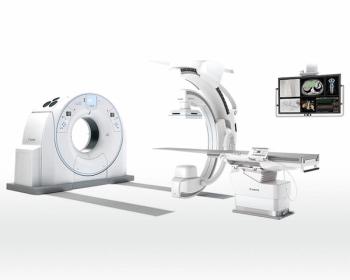
Lung Ultrasound Reveals COVID-19 Duration and Disease Severity
Images demonstrate high accuracy for identifying B-lines, thickened pleural lines, and pulmonary consolidation features.
Lung ultrasound can be highly effective for pinpointing B-line, thickened pleural line, and pulmonary consolidation features in patients who test positive for COVID-19, according to new research.
In an article published July 23, in the
“Our results,” said lead study author Yao Zhang, “indicate that lung ultrasound findings can be used to reflect both the infection duration and disease severity.”
To test the performance of these images, Zhang’s team performed lung ultrasound on 28 consecutive patients, between March 3, 2020 and March 30, 2020, who had positive RT-PCR test results for severe acute respiratory SARS-CoV-2. All patients – 14 men and 14 women – had positive findings both on lung ultrasound and chest CT.
According to their analysis of the ultrasound images, Zhang said, all patients had B-lines present, and 19 patients – 67.9 percent – had pulmonary consolidation. In addition, 17 patients – 60.7 percent – had pleural lines. Only one demonstrated a small amount of pleural effusion. The researchers also found that more patients who had longer disease duration experienced thickened pleural line, and those patients with more severe or critical cases had more pulmonary consolidation.
“A thickened pleural line was more frequently observed on ultrasound in patients with longer time intervals after the initial onset of symptoms,” said Zhang’s team.
They noted that the pulmonary consolidations in the more severe cases appeared as tissue-like hypoechoic regions, indicating a significantly reduced air flow and increased quantity of inflammatory cellular exudate.
“Our study shows that pulmonary consolidation depicted on lung ultrasound may serve as an alert in patient management,” Zhang said.
As a repeatable exam in COVID-19-positive patients, lung ultrasound can not only help providers objectively identify which patients have the most severe cases, but it can also ensure continued disease monitoring. This capability can be particularly valuable, Zhang said, in cases where chest CT is not available, such as in intensive care units or isolation wards.
Based on these findings, Zhang’s team said, severity score for lung ultrasound, similar to what exists for CT scans, should be developed to enable more accurate comparisons in future research endeavors.
Newsletter
Stay at the forefront of radiology with the Diagnostic Imaging newsletter, delivering the latest news, clinical insights, and imaging advancements for today’s radiologists.

























